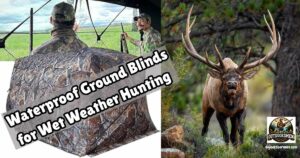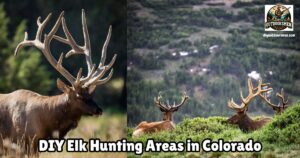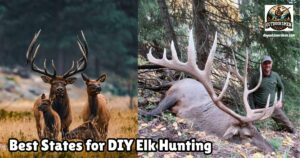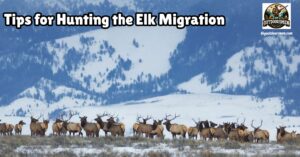Contents
- 1 Understanding Elk Migration Patterns
- 2 Scouting and Pre-Trip Preparation
- 3 Effective Hunting Tactics During the Elk Migration
- 4 Physical and Mental Preparation
- 5 Hunting Responsibly and Ethically
- 6 Common Challenges and Practical Solutions
- 7 Frequently Asked Questions About Elk Migration Hunts
- 8 Final Thoughts on Hunting the Elk Migration
Following elk migration during hunting season brings both excitement and new challenges. These large animals move across vast landscapes as the seasons change. Being able to predict where and when you’ll find them makes a huge difference in your success.
QUICK LOOK: Tips for Hunting the Elk Migration
- Elk Migration Patterns: Knowing how and where elk migrate is really important if you want to find them during hunting season. Elk move in response to several natural cues. The most obvious is the change in seasons.
- Preseason Scouting: Scouting before the season makes a huge difference. I start by using digital mapping tools such as onX Maps to pick out likely elk trails, saddles, drainages, and watering spots.
- Physical & Mental Preparation: Elk hunting during migration is physically demanding. The terrain is usually steep, rough, and sometimes covered with snow or mud. I find training for these hunts months ahead really pays off.
- Still Hunting: When elk hold in thicker timber, I slow down and cover ground quietly, stopping often to scan for movement or listen. Hunting freshly dusted snow after a storm is especially helpful because tracks are easier to spot, and elk move more during daylight.
- Calling: I practice both bugles and cow calls, even outside the rut. Cow calls can bring in curious elk or lure timid bulls, but I stay concealed and pick spots with good cover so approaching elk can’t easily spot me.
- Tree Stand or Ground Blind Hunting: If I locate a regularly used trail or water hole, setting up a stand pays off. During migration, elk can stick to routine paths, especially if they’re passing through unpressured land.
- Edge Hunting Around Private Land: Migrating elk sometimes avoid public land pressure by crossing into private property. By focusing on public land boundaries and corridors linking different parcels, I find herds slipping to and from safer ground.
Elk are highly adaptable, but migration routes tend to follow similar patterns each year. I’ve gathered tips that help me make the most of elk migration hunts while making sure every hunt stays ethical and safe.
Understanding Elk Migration Patterns
Knowing how elk migrate is really important if you want to find them during hunting season. Elk move in response to several natural cues. The most obvious is the change in seasons. In spring, elk travel from low-elevation winter ranges up to mountain meadows to feed on fresh grasses. In the fall, they come back down as snow builds up, searching for food and easier routes.
I always spend some time reading migration studies from local wildlife departments. These often show maps of where local herds move, which is a big help. Timing my trip to match these movements saves me a lot of trial and error. Weather, including snow depth and temperature patterns, influences exactly when elk start moving.
Heavy snow can push them down from high slopes sooner than usual. By keeping an eye on weather forecasts, I can adjust my trip and maximize my odds of seeing migrating herds. To truly get a sense of these patterns, I like to check out elk behavior throughout different times of the year.
During the early fall, for instance, some herds become more vocal or gather near traditional migratory corridors. If you can spend a couple of seasons just observing, you’ll pick up on unique local quirks that maps alone won’t show. This makes every scouting trip a learning opportunity and helps you time your hunt more precisely.
Scouting and Pre-Trip Preparation
Scouting before the season makes a huge difference. I start by using digital mapping tools such as onX Maps to pick out likely elk trails, saddles, drainages, and watering spots. Aerial images and topographical maps help me pin down likely choke points and migration corridors, places where elk have to pass through due to terrain.
When I’m in the field, I pay careful attention to elk sign. Fresh tracks, droppings, tree rubs, wallows, and disturbed ground show which routes are active. Bedding areas usually show up in thicker forest or on north slopes, while feeding tends to happen in open meadows or burns. By connecting these areas, I can plan where elk are most likely to travel each day.
Locating pinch points is one of my favorite strategies. Elk often use natural features like ridges and saddles to move safely, and finding these spots helps set up better hunting opportunities. Water can be scarce during migration, so I always mark all sources I find on my map. Early mornings and late evenings are the best times to see elk moving, so I focus my efforts then.
Don’t forget to check with local game wardens or biologists. These experts not only know migration paths but can offer insights on recent changes due to fires, logging, or increased recreational use. Sometimes, a quick conversation helps you stumble upon overlooked routes or tells you where pressure has recently shifted herds. Bringing in multiple information sources during your preparation phase always gives you an edge.
Effective Hunting Tactics During the Elk Migration
Elk hunting during migration calls for a blend of patience and smart tactics. Glassing is how I usually start my day. With good binoculars and a spotting scope, I scan likely areas before moving. Watching for single-file lines in open snow or meadows often reveals traveling groups.
- Still Hunting: When elk hold in thicker timber, I slow down and cover ground quietly, stopping often to scan for movement or listen. Hunting freshly dusted snow after a storm is especially helpful because tracks are easier to spot, and elk move more during daylight.
- Calling: I practice both bugles and cow calls, even outside the rut. Cow calls can bring in curious elk or lure timid bulls, but I stay concealed and pick spots with good cover so approaching elk can’t easily spot me.
- Tree Stand or Ground Blind Hunting: If I locate a regularly used trail or water hole, setting up a stand pays off. During migration, elk can stick to routine paths, especially if they’re passing through unpressured land.
- Edge Hunting Around Private Land: Migrating elk sometimes avoid public land pressure by crossing into private property. By focusing on public land boundaries and corridors linking different parcels, I find herds slipping to and from safer ground.
Mixing these tactics helps me adapt to changing elk movement and weather conditions. Slow, quiet movement is often more effective than trying to cover lots of ground quickly. Most of all, I stay patient because elk can be unpredictable.
Sometimes, bumping into other hunters is inevitable during migration hunts, especially in popular corridors. If I encounter more pressure than expected, I might move laterally along the migration route or seek out smaller, overlooked drainages.
Thinking on your feet and observing where the least pressure is happening keeps you in the game even when elk get pushed hard. A willingness to step away from well-traveled trails can net you undisturbed herds and better shot opportunities.
Physical and Mental Preparation
Hunting the elk migration is physically demanding. The terrain is usually steep, rough, and sometimes covered with snow or mud. I find training for these hunts months ahead really pays off. My routine includes hiking with a pack, building leg strength, and adding cardio so I can keep up with migrating herds if needed.
Mental readiness is just as important. Some days I see no elk, or tough weather forces me back to camp. Keeping a positive attitude and focusing on what I can control helps me handle setbacks. Staying flexible with plans and accepting that migration patterns mix it up helps me avoid disappointment and stay motivated.
Layered clothing helps keep my body comfortable as temperatures change through the day. Waterproof boots and good socks matter more than most people realize. Keeping my feet dry and comfortable lets me hunt longer. Carrying water and small snacks is a must because clean water is sometimes tough to find in the mountains.
Spending a few nights camping at high elevation before your hunt to get used to the altitude can also pay off. Your mind and body will operate better, and you reduce the risk of fatigue or illness. I take a little time each evening to reflect on what worked or didn’t work during the day, so I’m always growing as a hunter. Sticking to a simple stretching routine before bed knocks off some soreness, so I wake up ready for the next effort.
Hunting Responsibly and Ethically
Hunting during elk migration means keeping respect for the animals and the land front and center. I practice fair chase by allowing elk enough room and opportunity to escape, avoiding unethical tactics like shooting from vehicles or using drones to spot animals.
Shot placement matters. I practice with my rifle or bow throughout the year to know my range and skill limit. Taking only shots where I’m confident of quick, clean kills means less suffering for the animal and better meat quality.
I follow all state and federal hunting rules, and I keep up with changing regulations or land closures affecting migration routes. Packing out all my trash and avoiding damage to sensitive areas matters to me because it keeps the land healthy for wildlife and future hunters.
For many hunters, sharing the hunt’s story, photos, or meat with family and friends adds meaning, but I never forget to make sure these stories highlight both the thrill of the chase and the respect owed to the animal. Being an ethical hunter improves public perception and keeps access open for generations ahead.
Common Challenges and Practical Solutions
Hunting the elk migration brings some real challenges, but there are solid ways to tackle them. The biggest one for me has always been unpredictable weather. Packing extra clothing layers and waterproof gear helps me stay comfortable even when a sunny morning turns into a snowy afternoon.
Keeping up with fast-moving herds is another common issue. Using a GPS tracker or an offline mapping app helps me find my way and avoid getting turned around in new country. When elk suddenly change course, I rely on recent sign and am ready to adjust plans on the fly.
Elk herds might migrate faster or slower depending on hunting pressure. If I see an area getting crowded, I switch to less popular spots or move farther from roads. Sometimes a hike of just one extra ridge gets me away from other hunters and increases my chances.
Finally, fatigue and discouragement can set in after multiple long, tough days. I’ve learned to set small goals each day, like reaching one new vantage point or finding fresh tracks, to keep myself moving forward. Staying connected with other hunters through inReach devices or scheduled check-ins also adds an extra layer of safety when far from roads or in remote mountain country.
Frequently Asked Questions About Elk Migration Hunts
Here are some questions I often receive from new elk hunters or friends joining me during migration season:
How do I find out when elk are moving in my area?
Local wildlife agencies often publish migration updates, and chatting with other hunters or land managers helps gather real-time information. Watching for sudden temperature swings or early storms also gives clues to when elk start mixing up elevation.
What’s the best way to prepare physically for elk migration hunting?
Building leg strength and endurance is the top priority. I hike with a loaded pack, train on stairs or hills, and aim to match the elevation gain I’ll likely face in the field.
What are the main rules I need to follow for ethical hunting?
Following all posted regulations, using fair chase principles, and practicing shot discipline are the biggest. I also recommend talking with landowners if you’ll be near private land and always respecting property boundaries.
Final Thoughts on Hunting the Elk Migration
Hunting elk during their migration is challenging but deeply rewarding. Understanding the rhythm of elk movement, keeping up with scouting, and using adaptable hunting strategies all make a difference.
Keeping fit, staying mentally focused, and sticking to ethical practices let me enjoy each trip for years to come. Solid preparation, steady patience, and respect for the land and animals help ensure hunts that are memorable in the right ways.
Most Recent Articles:
- 14 Tips And Tactics For Public Land Mule Deer Hunting

- 6 Features of Waterproof Ground Blinds For Wet-condition Elk Hunting

- 4 of the Best DIY Elk Hunting Areas In Colorado

- 8 Tips for Choosing the Best DIY Elk Hunting States

- 5 Hunting Gear Packing List Essentials For DIY Trips

- 7 Tips For Hunting The Elk Migration

As always, stay safe, enjoy the journey, and please try to leave it cleaner than you found it. If you have any comments, questions, ideas, or suggestions, please leave them in the comment section below, and I’ll get back to you ASAP. You can follow us on YouTube: Man Art Creations for videos of our DIY Adventures.
P.S. Thanks so much for checking out our blog; we really appreciate it. Just so you know, we may receive a commission if you click on some of the links that appear on our site. This helps us keep our content free and up-to-date for everyone. We appreciate your support!



